Scout 4 is Late!
Finally, here is my take on an Aichi E13A floatplane better known as a Jake, and ‘Scout 4', that catapulted from the Japanese cruiser Tone, during The Battle of Midway, on the morning of June 4th 1942, and much like its reasonably famous subject, it is running a little late. Apologies, at the last minute life got in the way!
Suggestions as to why it didn't take off on time to fly its designated pattern with the other scouts, include a failed catapult (most commonly reported) or engine trouble. Another story, more in keeping with the view that the Japanese commanders were stereotypically self-confident, was that the search for US vessels was done in a perfunctory way, and the commanders of the spotter planes were under-prioritised and left waiting for orders.
Whatever the reason that PoC1 Hiroshi Amari, commander of Tone's E13A number four, set off late, there are conflicting opinions on the importance and effect of his tardy launch. ‘Shattered Sword' goes into some detail about possible flight patterns for the scout planes and the repercussions of Scout 4's late start. It says that Amari may either have cut his flight short to prevent the need of a late recovery by Tone; or may have been avoiding contact with a Catalina in the same area. Either way it lead him to find a significant part of the US fleet.
The search by Amari and his crew has been described by some as a poor effort, although his comrades in Chikuma's Scout 5 reportedly missed Task Force 17 (which they should potentially have spotted) due to what has been referred to as ‘halfhearted' flying – staying above the clouds and looking through gaps, rather than suffering the weather below to carry out a thorough job. Scout 4 picked up ‘10 surface ships' on the return leg of its flight, that should have been spotted earlier by Scout 5.
The crew of Scout 4's biggest failing was to miss an aircraft carrier in the group, until an hour after its first sighting. This may have been due to poor spotting or bad weather; it remains unclear since none of the scout crews lived out the war, and the full story died with them. Whether improved performance by the crew of Scout 4, and its commanders, would have made a difference, given that US aircraft were already aloft, is again a matter for discussion.
During the search, Vice-Admiral Nagumo received the following transmissions from Scout 4:
0728: "Sight what appears to be ten enemy surface ships, in position 10 degrees, distance 240 miles from Midway. Course 150 degrees, speed over 20 knots".
0758: "...the enemy is on course 80 degrees, speed 20 knots".
0809: "Enemy ships are five cruisers and five destroyers".
0820: "Enemy force accompanied by what appears to be aircraft carrier bringing up the rear".
Nagumo's decision and timing to change the ordnance on the Japanese carrier planes that followed, and was so fateful as the Battle unfolded, was informed by these messages from Scout 4.
Although there are many ways to interpret the outcomes of the flight of Scout 4, both in terms of competence and good or bad fortune, in their final analyses many commentators advocate that it speaks to the stereotypes of the Japanese command and their offensive bias, that they may have fatally misused and under-resourced their reconnaissance at Midway.
As to the model I built there are some issues. It may in fact be the wrong machine entirely, incorrectly painted and inaccurately marked!
Reports, facts and suggestions in the better-known books and the various Midway web communities throw up more questions than answers about the ‘Scout 4' aircraft. Although definitive truths may exist in untranslated Japanese texts, it is more probable that they are now unlikely to be clarified at all.
Without going into detail, I had to consider the following to build an approximation of Scout 4:
-
Was this aircraft a Jake or Dave? Most consider it a Jake, but it is not impossible that it was a Dave as both types of reconnaissance aircraft had been aboard Tone. Kates were also used as search planes by the Japanese before the battle.
-
Was the paint scheme grey or green? If I were to have based the decision for my build on what I had read, I'd say grey, on balance. However, there is no definitive reason that it could not have been green as many planes were repainted ‘around' that time, and in the field. Would that have happened on a carrier? In a discussion on another thread about weathering Tom Cleaver clarifies that these planes would have been very well cared for and routinely treated and touched up to protect against salt corrosion, so there is no reason to think it impossible that they could have been given an updated scheme (they were grey at Pearl Harbour). I chose green as there is a photograph in Shattered Sword showing the floatplanes on Tone (a distant and grainy shot) where the planes look slightly darker than the background colour of the ship itself. As with all black and white photographs of a certain age it is very difficult to judge colour and this is often made trickier by the light conditions in which the exposure occurred.
-
Were the Hinomaru plain red or bordered? Although there are no detailed photographs of the Scout 4, most reports suggest borders in white/cream.
To recognise the possibilities that the plane was delayed by mechanical issues I have made the plane with its cowling off and added a Kinsei 43 radial engine (by Vector). It is likely that Scout 4's engine may have needed a check over, at very least, before it could be launched, since it is said that the power plant needed to be running flat out for an aircraft to successfully escape the catapult, even with the force of the explosive charge. The engine mount is very ‘speculative' and scratch built from styrene.
If the original engine ‘face' on the Nichimo 1/48th scale Jake was primitive, the cockpit was non-existent, having been omitted to make space for a small motor to run the propeller! The cockpit in my attempt is based on a Val resin set (CMK) and I had to invest a lot of time trying to manufacture a fit. Eventually, having cut out a lot of plastic, and sanded my life away, it just about married up. I also added a VKS resin Browning 7.7mm machine gun to improve on the kit part.
Although this kit borders on antique the fit was astonishingly good in parts. Being able to position the control surfaces freely was also nice. In keeping with Tom Cleaver's information on weathering I used pre-shading in an attempt to achieve some subtle fading without deterioration of the paint job. To retain the look of a well-maintained and looked after aircraft I opted for a much ‘cleaner' finish than I might usually employ!
For a Brit, with a ‘European' view of ‘39-45', engrained by ‘The World at War', my father's collection of books, and growing up in a culture rich in tales of Dunkirk, The Battle of Britain, The Blitz, and hunting The Bismarck, the Midway group build has been a brilliant learning experience. So many people in this huge group effort have produced such outstanding models and related such great stories of the courage of the servicemen involved and their machines, that my Second World War understanding has once again grown significantly. It has been a real pleasure watching the builds develop. So finally, I'd like to thank everyone who guided me through discussion, but especially Louis of course, who not only did an outstanding job of co-ordinating the group but even sent me photographs of the instructions for the Nichimo Jake in English! If the ‘cat' build is half as good it will be sensational!
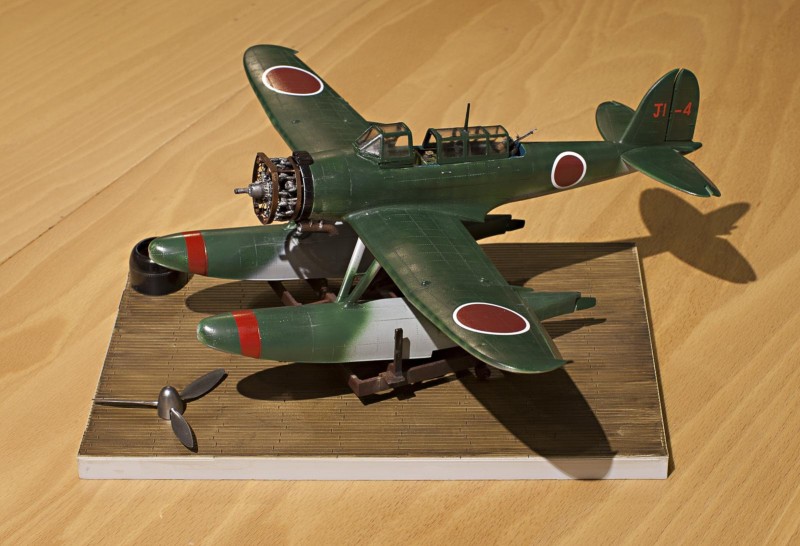


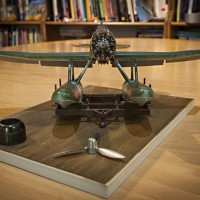
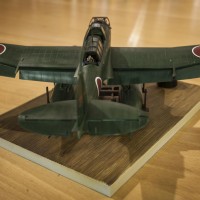
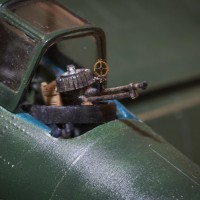

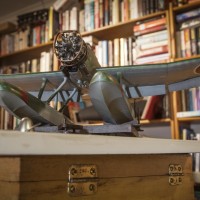

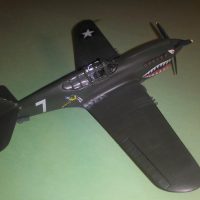
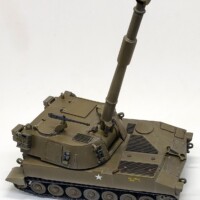
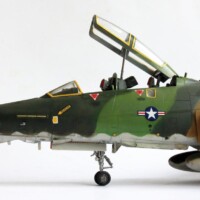
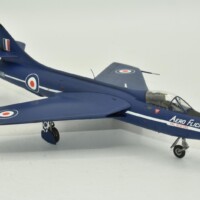
Nice lookin' job, Paul...I like that base, too. Good work, my friend!
Wow, you have made that ancient reeker look good!
Not that I am a Jake expert, but from what I do know, you've likely created a later production Jake. The early ones (which most likely would have been aboard Tone and Chikuma at Midway) didn't have the inner bracing struts to the floats. That's not a criticism, I've only had someone take note of that in the past year of discussing these things. "Jake experts" are thin on the ground.
For anyone interested, Mike West at Lone Star Models did a resin upgrade for the kit, with an accurate resin cockpit and several other corrections. I don't know if it's still available.
A beautifully done model Paul! I've been wondering which Japanese single-engine subject to tackle next, and this has set me itching to add a Jake to the short-list!
Thank you gentlemen. Tom, I did contact Mike West, it wasn't available - which was a real pain! And yes the kit does depict a later model, so I left off the surface radar of the E13A1b (the only difference I could find documented), but never knew about the float struts!
And Greg, oddly enough I would recommend it, although Hasegawa did a 1/72 version with a catapult. I'm not sure the photos convey how big this kit is - the aircraft itself was a healthy size!
Fantastic work Paul !
Your "Jake" really turned out very nice... True to the original, your "Scout 4" was a little late too. 🙂 🙂 🙂 that's OK by me.
Wow the resin engine upgrade is a huge improvement too. as are the cockpit and rear gun additions you made.
Two thumbs up Sir ! Glad I could help with it...
I'm getting ready to pull the trigger on the "Year of the Cat" build next... Thanks for the compliments to our Midway Group build. It really turned out much better than I ever anticipated.
Thanks again my friend.
If you want me to, I can edit the Midway Group reveal summary and add your plane to it. Please let me know if that's OK for you.
That would be great Louis, thank you!
No problem buddy. I'll handle it right now...
It's done... check it out if you can.
Just had a chance to take a look Louis - thanks so much - very kind!
Paul, that turned out beautifully, given what you had to work with. I've got one, so I know. Shame Mike West didn't still have his cockpit set for this. Maybe he'll reissue it at some point, seeing that in 48th it's the only game in town, still. Unless, if we're lucky, Hasegawa adds to its series of 48th floatplanes, like their Pete and recent Dave. It would seem a natural addition, at least to me.
Fine work Paul,another plane I like anything that does not always have wheels,great weathering in all a great build..
Very nice! An interestng background story also.
Like all good things it was worth waiting for - lovely work Paul!
Hello Paul,
Nice build of this "historical"airplane.
I appreciated your full story with the model. Both sides made massive mistakes. The US could repair these quickly, Nippon never recovered from it.
Regards, Dirk / The Netherlands.
Very nice work on this kit
Paul, this is great! I do love floatplanes, & this one is great. Your narrative is excellent as well.
Thanks for sharing!
Excellent work, Paul! And so spot on with the historical aaspect of your build. "Shattered Sword" is the "Go To" book on the Midway battle...(Well along with John Lundstrom's awesome book about the "First Team" it is..)
What did you do to enhance this kit? I never knew this was such a decent kit.
Again, very nice work, and BRAVO on your additionto the group build
Frederick, thank you - the kit was basically cut away and little of the original cockpit and cowl remain - the detail in the engine, cockpit and gun are all resin with little bit of scratch as stated! It was my first try at such modification so I am satisfied overall.
Hi Paul @yellow10!
This is a fantastic looking Jake.
I'm currently building one for the EoJ GB and will use your build as my guideline, if it's ok with you.
One question: did you put weight at the front of the floats during assembly? Is the model tail-heavy?
All the best, my friend.